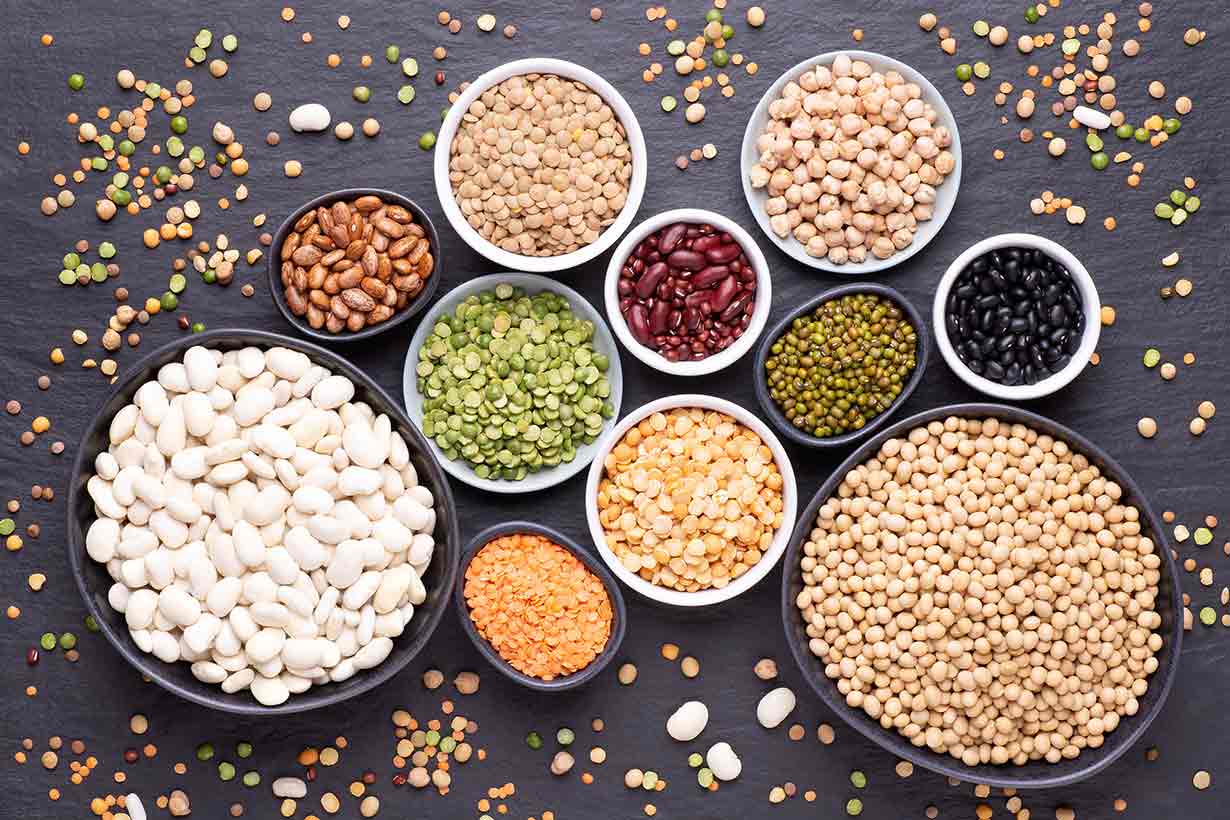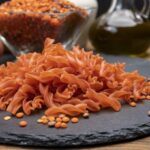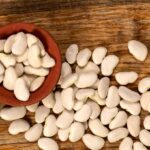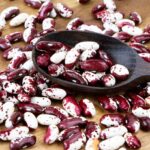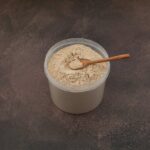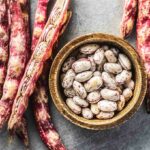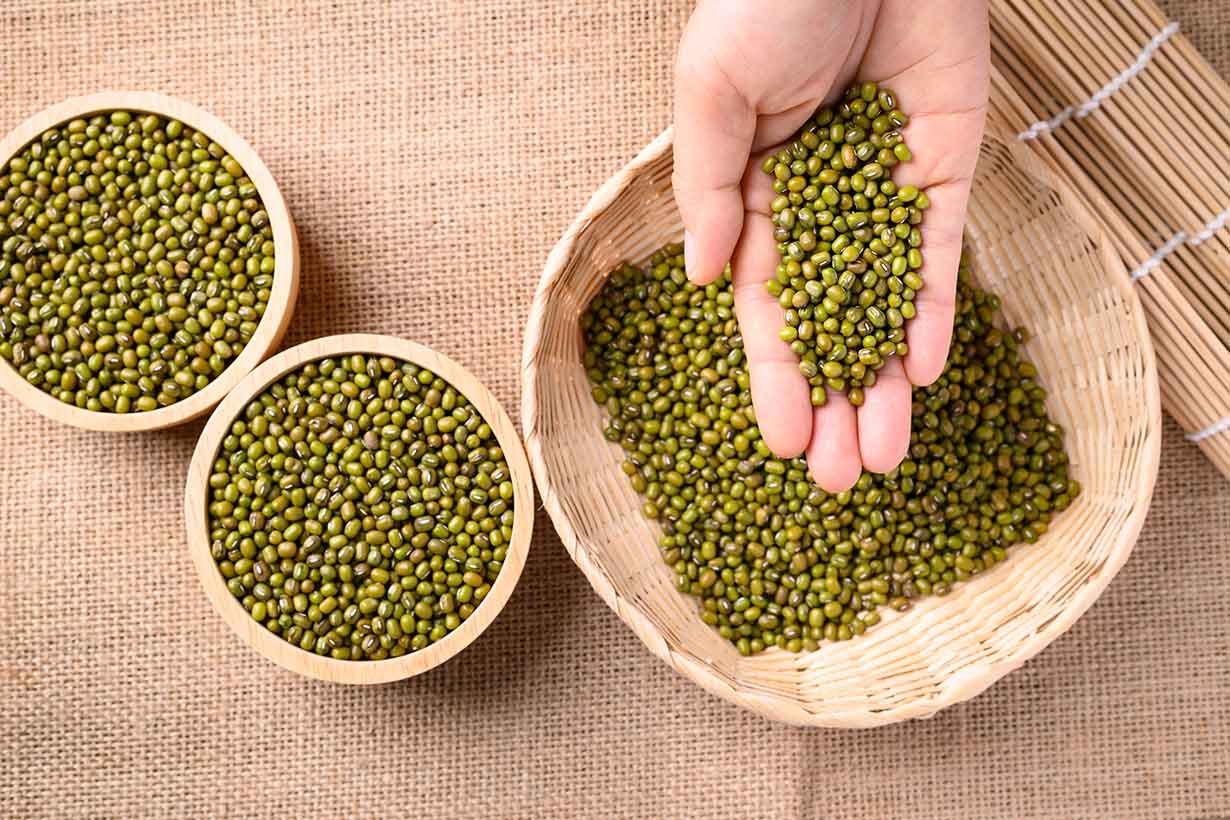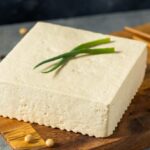Disclosure: This post may contain affiliate links. This means if you click on one of these links and purchase an item, we will receive a small commission at no extra cost to you. All opinions are our own.
Moth beans are one of the lesser-known legume varieties. However, they offer significant nutritional value.
These little beans provide high levels of protein and a wide array of essential vitamins and minerals.
This article explores the nutritional attributes of moth beans, shedding light on their potential benefits and downsides.
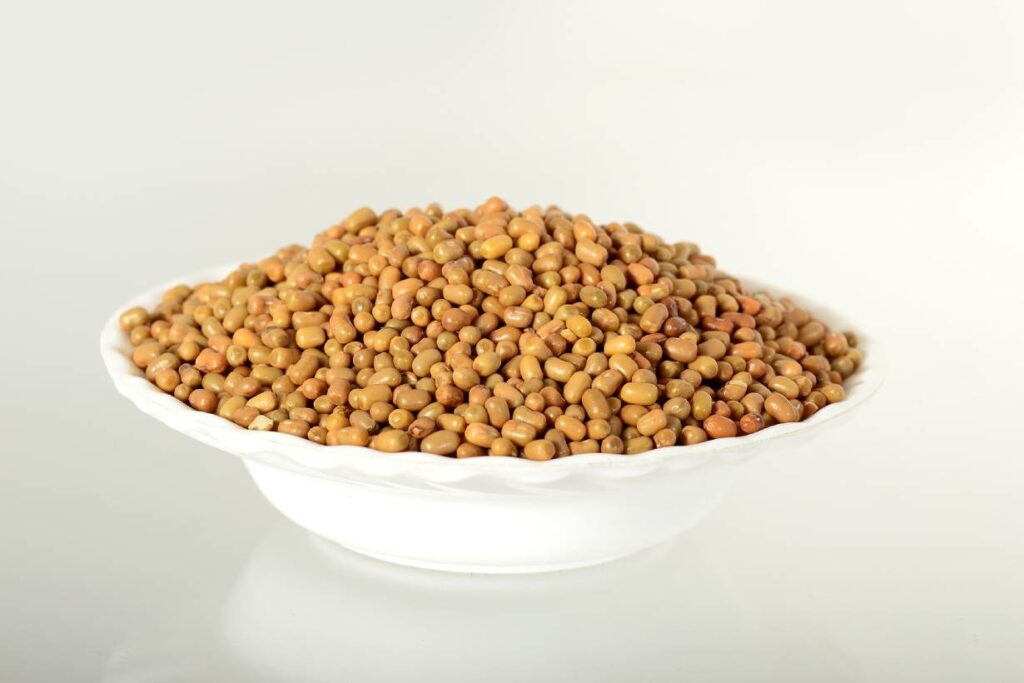
Table of contents
What Are Moth Beans?
Moth beans, scientifically known as Vigna aconitifolia, are part of the Vigna genus. This genus of plants encompasses various legumes, including adzuki beans, black-eyed peas, and mung beans (1).
Moth beans also go by the names of dew grams, mat beans, and matki.
While these beans enjoy global availability, they are most popular in South Asia, featured as a staple food in Indian cuisine (2).
Moth beans play a versatile role in numerous recipes.
Among these recipes, one notable dish is ‘matki usal,’ a traditional Indian curry featuring moth beans, tomatoes, and a range of spices (3).
The Nutritional Profile of Moth Beans
The following table displays a comprehensive breakdown of the nutritional values of raw moth beans per 3.5 ounces (100 grams).
The data source for these nutritional values is the USDA’s FoodData Central database. Daily values were determined by combining this USDA data with the FDA’s recommended daily values (4, 5).
Please note: While the USDA data did not provide information on the fiber or vitamin E content of moth beans, studies examining the nutritional composition of moth beans supplied the missing data on fiber and vitamin E content (2).
| Name | Amount | % Daily Value |
|---|---|---|
| Calories | 343 kcal | |
| Carbohydrates | 61.5 g | 22.4% |
| Fiber | 15.12 g | 54% |
| Sugars | – | |
| Fat | 1.61 g | 2.1% |
| Saturated | 0.36 g | 1.8% |
| Monounsaturated | 0.13 g | |
| Polyunsaturated | 0.75 g | |
| Omega-3 | 0.265 g | |
| Omega-6 | 0.485 g | |
| Protein | 22.9 g | 45.8% |
| Cholesterol | 0 mg | 0% |
Vitamins
| Vitamin | Amount | % Daily Value |
|---|---|---|
| Choline | – | |
| Folate, DFE | 649 mcg | 169.8% |
| Vitamin A | 2 mcg | 0.2% |
| Vitamin B1 (thiamin) | 0.562 mg | 46.8% |
| Vitamin B2 (riboflavin) | 0.091 mg | 7% |
| Vitamin B3 (niacin) | 2.8 mg | 17.5% |
| Vitamin B5 (pantothenic acid) | 1.54 mg | 30.8% |
| Vitamin B6 | 0.366 mg | 21.5% |
| Vitamin B12 | 0 mcg | 0% |
| Vitamin C | 4 mg | 4.4% |
| Vitamin D | 0 mcg | 0% |
| Vitamin E | 0.79 mg | 5.3% |
| Vitamin K | – | – |
Minerals
| Mineral | Amount | % Daily Value |
|---|---|---|
| Calcium | 150 mg | 11.5% |
| Copper | 0.688 mg | 76.4% |
| Iron | 10.8 mg | 60% |
| Magnesium | 381 mg | 90.7% |
| Manganese | 1.82 mg | 79.1% |
| Phosphorus | 489 mg | 39.1% |
| Potassium | 1190 mg | 25.3% |
| Selenium | 8.2 mcg | 14.9% |
| Sodium | 30 mg | 1.3% |
| Zinc | 1.92 mg | 17.5% |
Benefits of Moth Beans
Now, let’s delve into some of the primary benefits of moth beans.
Given the limited amount of research specific to this legume, most of these benefits stem from the nutritional composition of the beans.
High Protein Content
Like many legumes, moth beans boast a large quantity of protein.
In their dried and uncooked state, each 100 grams of moth beans contains 22.9 grams of protein (4).
For those curious about the protein content of cooked moth beans, each 177-gram cup offers approximately 13.8 grams of protein (6).
Excellent Source of Folate
Moth beans stand out as one of the best dietary sources of folate, an essential mineral crucial for DNA production and the maintenance of healthy cells. Ensuring a sufficient intake of folate during pregnancy also reduces the risk of birth defects (7).
In every 100 grams of moth beans, there is a folate content of 649 mcg, equivalent to 170% of the recommended daily value (4, 5).
Very few foods match the folate content found in moth beans.
Substantial Magnesium and Potassium Content
Magnesium and potassium are essential minerals that many individuals fail to consume in sufficient quantities. This is especially true for potassium, which has been flagged as a ‘dietary components of public health concern’ by the Dietary Guidelines for Americans (8, 9, 10, 11).
In line with this, research indicates that the average daily potassium intake in the United States was 2496 mg in 2017-2018. However, the recommended daily value for potassium is 4700 mg per day (5, 12).
Moth beans offer a substantial amount of both magnesium and potassium.
Based on their raw weight, 100 grams of moth beans provide 381 mg of magnesium, which accounting for over 90% of the recommended daily value. As for potassium, 100 grams of moth beans supplies 1190 mg, equivalent to more than 25% of the daily value (4, 5).
Phytochemical Content
We frequently hear discussions about phytochemicals like carotenoids and polyphenols as reasons to include fruit and vegetables in our diets.
However, it’s worth noting that legumes, including moth beans, are also rich sources of phytochemicals.
A 2016 study evaluated the phytochemical content of moth beans and revealed the presence of various compounds, including (13):
- Phytic acid
- Tannic acid
- Trypsin inhibitors
It’s important to note that each of these compounds can have anti-nutritive effects, meaning they can lower the absorption of specific nutrients. We’ll delve into this further in the ‘downsides’ section of this article.
However, these compounds can also offer health benefits, such as functioning as antioxidants, exerting anti-inflammatory effects, and helping to prevent lipid peroxidation (14, 15, 16).
Moth Beans Grow Well In Arid Places
While not a nutritional benefit as such, one potential advantage of moth beans is their ability to grow in arid locations.
In a study published in 2023, the beans were described as “a minor legume with major potential to address global agricultural challenges” (2).
The authors highlight in their paper that moth beans could to play a vital role in ensuring food security and serving as an income source for farmers as global temperatures rise.
Given their tolerance to dry and arid conditions, moth bean cultivation could be utilized in areas prone to frequent droughts.
Drawbacks
There are also a few potential downsides associated with moth beans that we should keep in mind.
These include the anti-nutritional properties of compounds found in the beans and their lengthy cooking time.
Anti-nutrient Content
As mentioned earlier, moth beans contain phytic acid.
Phytic acid is an organic acid that contains phosphorus, and it is a type of phytochemical.
As discussed previously, phytic acid possesses several beneficial properties. However, it also exhibits anti-nutritional properties that can lower the absorption of certain minerals in food (17, 18).
This occurs through a process called chelation, wherein phosphate groups within phytic acid bind to minerals such as calcium, iron, magnesium, and zinc. This process forms new complexes that the body’s enzymes cannot digest (19, 20).
Therefore, not all of the calcium, iron, magnesium, and zinc present in moth beans will be absorbed.
Reducing the Phytic Acid Content of Moth Beans
As with other legumes, it is possible to decrease the phytic acid content of moth beans through either soaking or sprouting them.
While far from being necessary, individuals aiming to optimize the mineral bioavailability of moth beans may wish to look into it.
Soaking is a simple process, requiring the beans to be submerged in water for at least six hours.
Alternatively, moth beans can be sprouted, involving a series of soaking and draining cycles over several days.
For help with sprouting, a 7-step how-to guide is available here.
Long Cooking Time
Another aspect to consider is that moth beans, in their dried form, take a moderately lengthy cooking period.
This extended cooking time is not unique to moth beans, and it applies to various legumes, such as kidney beans, black-eyed peas, and others.
However, with many other legumes, pre-cooked canned options are available. These products require only a brief heating period before serving.
In contrast, due to moth beans being less common outside of South Asia, finding canned moth bean products can be challenging.
While readily available in their dried form, there isn’t a “quick cook” alternative for moth beans like there is for other legumes.
For those cooking moth beans that haven’t been pre-soaked, the average stovetop cooking time ranges from 40 to 50 minutes. That said, pressure cookers can significantly reduce this cooking time.
How To Cook Moth Beans
Cooking moth beans is fairly straightforward, although the specifics will vary depending on the available cooking equipment and whether or not the beans have been pre-soaked.
Here’s a brief guide to cooking moth beans using different methods:
- Stovetop cooking: Begin by bringing a pot of water to the boil, then add the moth beans and simmer for around 45 minutes if the beans haven’t been pre-soaked. Check that the beans are soft to confirm they’re ready.
- Pre-soaked beans on the stove: Pre-soaking moth beans can significantly reduce the cooking time. If the moth beans have been soaked overnight or for at least 5-6 hours, they will be softer and require less time to cook. Bring a pot of hot water to the boil, add the pre-soaked beans, and simmer for around 25-30 minutes until soft.
- Pressure cooker: Using a pressure cooker will result in a much shorter cooking duration, typically ranging from 10 to 20 minutes. Refer to your pressure cooker’s instructions for cooking dried beans.
Ways To Use Moth Beans
With their soft texture, moth beans are versatile and we can use them in a variety of ways:
- Curries: Add moth beans to a curry to thicken the texture while offering additional fiber and protein.
- Flour: Moth bean flour can be easily prepared by grinding whole, dried moth beans. A simple online search for ‘moth bean flour recipes’ will yield various recipe ideas.
- Matki usal: This is a famous regional dish hailing from Maharashtra, a state in India. It is a type of curry, and there is a good recipe for it here.
- Soups and stews: Due to their mild flavor, moth beans are well-suited for soups and stews, where they absorb the flavors of the dish.
- Stir-fries: Add some pre-cooked moth beans into stir-fries during the last few minutes of cooking.
Where To Buy
The easiest way to find moth beans is by checking grocery stores that specialize in Indian or Middle Eastern grocery products.
Large supermarkets may also stock moth beans, as well as health stores that stock legumes.
Aside from this, there is a wide variety of online stores that sell moth beans.
Among these, they are readily available from Amazon.
Final Thoughts
Moth beans boast an impressive fiber and protein content, but it’s not quite as high as some other legumes, such as navy beans.
These beans are also rich in folate, B vitamins, and a broad range of minerals.
Moth beans have a tender texture and a subtly mild flavor, making them a versatile addition to many dishes.
For those unfamiliar with moth beans, they are worth a try. However, they don’t offer any unique nutritional benefits that warrant choosing them over other legumes.
References
- https://edis.ifas.ufl.edu/publication/MV021
- https://pubmed.ncbi.nlm.nih.gov/37346119/
- https://www.vegrecipesofindia.com/matki-amti-recipe-amti-recipes/
- https://fdc.nal.usda.gov/fdc-app.html#/food-details/172425/nutrients
- https://www.fda.gov/food/new-nutrition-facts-label/daily-value-new-nutrition-and-supplement-facts-labels
- https://fdc.nal.usda.gov/fdc-app.html#/food-details/172426/nutrients
- https://ods.od.nih.gov/factsheets/Folate-Consumer/#h6
- https://www.dietaryguidelines.gov/resources/2020-2025-dietary-guidelines-online-materials/food-sources-select-nutrients
- https://pubmed.ncbi.nlm.nih.gov/36460120/
- https://pubmed.ncbi.nlm.nih.gov/30200431/
- https://pubmed.ncbi.nlm.nih.gov/30513803/
- https://www.ncbi.nlm.nih.gov/books/NBK587683/
- https://www.ncbi.nlm.nih.gov/pmc/articles/PMC4867057/
- https://pubmed.ncbi.nlm.nih.gov/2182395/
- https://pubmed.ncbi.nlm.nih.gov/33992384/
- https://pubmed.ncbi.nlm.nih.gov/34991392/
- https://pubmed.ncbi.nlm.nih.gov/8777015/
- https://www.hsph.harvard.edu/nutritionsource/anti-nutrients/
- https://pubmed.ncbi.nlm.nih.gov/35010899/
- https://www.ncbi.nlm.nih.gov/pmc/articles/PMC7600777/

